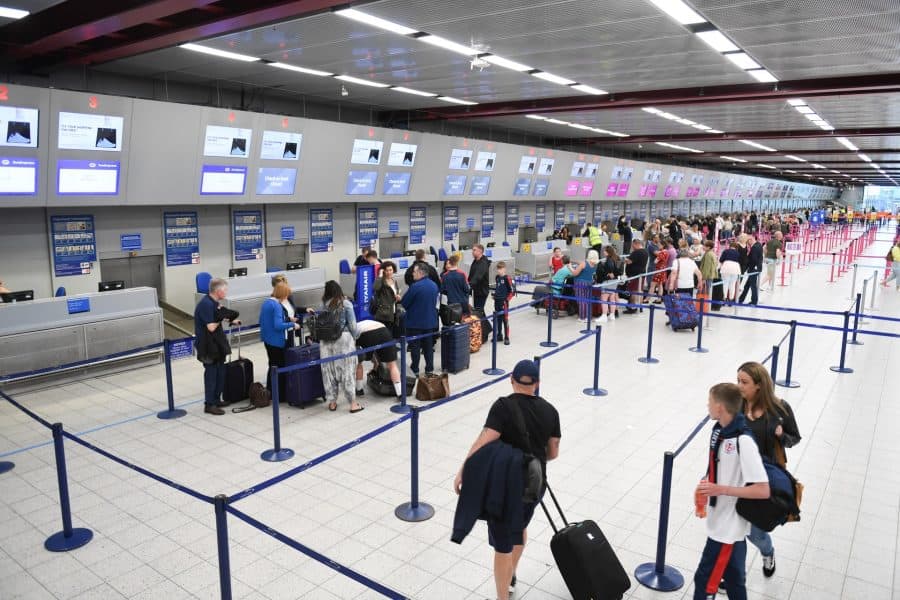The Complete Guide to Airplane Window Shade Etiquette
Picture this. You are sitting in the most undesired seat on the airplane, the middle seat, stretched between two strangers and trying hard not to elbow them as the lack of space encloses you on either side. To top it all off the sunlight from the window is blinding you in the face, but you don?t control window shades because you are in the middle seat.
Do you sit back and just deal with the ride, as you casually lean forward in an awkward position to avoid the sun and hope that your seat neighbors do not think you are a complete weirdo for bending at an awkward angle over their airport tray lunch as if you are straddling their yogurt while leering at what is on their media screen? Or do you ask them to put down the shade?
When you book the window seat you have certain expectations about your flight experience. After all, part of the fun is that you get to stare out the window at the amazing view. But when your habits affect other passengers, what is considered polite? What is not polite? What are the standards of window shade etiquette to follow? How do these standards change when you are the person in the aisle seat versus the person in control of the window shade? This article takes an in-depth look at everything you need to know about window shade etiquette on airplanes.
Who controls the window shade?
Ultimately, the ruler of the window shade is the person who bought the window seat. After all, if you paid for the window, you do expect to get the privileges of the window, the view, and of course, the shade.
Some people believe that the person who is sitting by the window is selfish because they make the decisions as to whether to leave the window up or close it, for the entire flight. However, there are many reasons why someone chooses to buy the window seat and not all of them are selfish.
Sometimes, people just enjoy the view and their choice was purely for aesthetic reasons. However, some people tend to feel claustrophobic and thus book the window seat to have the window open. This can provide a feeling of comfort for the passenger. It has also been reported that looking out the plane window can alleviate motion sickness. Some people even claim that getting the proper amount of sunlight by staring at the horizon can help combat jetlag. No matter what their preference is, if the window shade?s position is bothering you, the window passenger is probably not intentionally trying to make you uncomfortable. In fact, chances are, they do not even realize that there is a problem. So if you are not in control of the window shade, is there anything you can do to change its position?
How can you change the window shade position if you are not sitting in the window seat?
As the window belongs to the window seat passenger, so does the control of the window shade. However do not despair, as a general rule of thumb, a middle seat or aisle seat person can always politely ask the window seat passenger to open or lower the shade.

As long as you are polite, simply asking the passenger if they can raise or lower the window shade is considered normal. However, be prepared that they may not comply with your request. Again, they are sitting in the window seat, therefore it is their decision.
Can the flight attendant talk to the window seat passenger on your behalf?
If you find yourself seated far away from the window seat passenger but their window shade is disturbing you, you can also talk to the flight attendant. The flight attendant can ask the passenger to change its position on your request. However, only do this if the passenger is not seated near you, for example, you are in the middle row and the window shade six seats away is causing a glare on your computer screen. This is considered polite as you do not have to lean over a large group of passengers to talk to the person in the window seat.
However, only do this if the person is not seated near you. It would be awkward, and rather rude, to request the flight attendant to tell the passenger seated next to you to close the shade.
If I am not sitting by the window, can I just close the window shade myself if it is within my reach?
If you are not seated by the window, do not reach over the window seat passenger and mess with the shade. This is akin to a taxi passenger changing the taxi driver?s radio. It is considered rude and may even cause an argument.
Even ruder is changing the position of the window shade when the window seat passenger has left to use the bathroom. If the shade position is causing a problem, simply ask them if it can be changed. Do not physically take matters into your own hands. It comes off as passive aggression.
So, we know how to handle a situation where you are not sitting in the window seat and would like the window shade position changed. But what is typically considered to be polite window shade behavior when you are the one in control of the window seat?
You are sitting in the window seat, so what is considered polite when you control the window shade?
To quote the famous words of Uncle Ben from Spiderman, ?with great power comes great responsibility.? If you are that lucky person with control over the shade, it is generally nice to be polite and take into account the other passengers? experience. If you notice there is sunlight shining directly into your neighbor?s entertainment system, ask them if they would like you to shut the shade. Or better yet, just close it yourself.
Of course, it is impossible to know everything and it may so happen that you unintentionally annoy another passenger with the position of your window shade. If someone asks you to open or shut the shade, as long as the exchange is reasonable, take into account their needs as well as yours.
The decision of what level the shade is drawn is entirely up to you. But many window seat passengers continue to feel nervous about wielding this responsibility. Luckily, there are a few rules of thumb that you can follow that can help avoid unintentionally annoying other passengers.
Open or closed?
As a general rule, though the window seat passenger has control of the window, there is a proper way as to how to wield this power. It is recommended to choose a window shade position and stick with it for the majority of the time. Do not constantly change the position every five minutes. Every time you readjust the shade, someone else is likely affected and thus they have to change their seating position every time the shade is readjusted.
Choose either to have the shade open, closed, or somewhere in between, and do not change the position too much. This is the best way to avoid irritating your fellow passengers.
Are the rules the same for short-haul and long-haul flights?
There is a big difference when you travel on a plane for eight hours than a short-haul one-hour flight. Long-haul flights often have a set of their own needs. People do a variety of different activities on long-haul flights they would during a shorter flight time. There are meal times, sleep times, and extended hours where passengers are using their laptops or the in-flight entertainment system. Try to be polite to the people around you, especially if you notice your window is creating a glare on their screens.

It is appropriate to change the window shade level throughout a long-haul flight. However, just like as mentioned above, make sure not to be changing it every few minutes.
If you are traveling during a flight that includes a set-aside time for sleep, it is generally considered polite to lower the blinds. Especially if it is light outside when the majority of people are sleeping.
You can typically take the cues from the airplane lights. When they dim, the airline is trying to mimic night and give passengers a period to sleep with the hopes that the sleeping time will lessen jetlag. As such, if you notice it is still very light out, it is better to shut the shade when the lights are dim.
Are there any airline policies regarding window shades?
With all the talk of how the person sitting in the window seat has control of the shade, there is one other person whose rules? take precedence over the window seat passenger, and that is the words of the airline attendants. While it may feel violating for someone to regulate what you do with your window, the flight attendant?s rules trump all.
It is important to remember that when the flight attendant requests something, this is often because there are airline rules and regulations that they are following and have been hired to enforce. They are simply doing their job. Some airlines have specific rules and regulations regarding window shades, especially during take-offs and landings. For some airlines, any formal rules only apply to these times. However, other airlines have additional politics regarding if windows can be open or closed.
Airline window shade policies during takeoff and landing
In the United States, it is Federal Law that the window shades be open during takeoff and landing. So when they announce for you to keep the window shade open, this is not an airline-specific policy. This is the law. This rule also applies to many other countries in the world.
Window shades are to be kept open as a safety regulation. Most airline accidents happen during takeoff and landing. If there is an emergency and the plane needs to be evacuated, the crew has only an estimated 90 seconds to evacuate the aircraft. As such, the crew needs to be able to see out the windows quickly so they can decide as to where it is safe to let passengers out. It also assists the crew in assessing the location of any technical failures and the extent of the damage to the aircraft.
Furthermore, if you are in a dark room, it takes time for your eyes to adjust to the daylight. If there is an emergency and the attendants manage to get the window shades open fast enough, they then have to give their eyes time to adjust. Unfortunately, in emergency situations, every second counts so it is best to be prepared in advance in the unlikely event of an emergency.
In addition to it aiding the flight attendants, it also allows for fire crews outside to see if there is smoke in the cabin. With open window shades, the fire crews can better respond to an emergency situation once the airplane lands. So not only are you aiding the crew, but you are also helping the emergency response team by complying with airline regulations.
You, the passenger may also be able to assist in spotting a problem outside. There have been rare incidents during takeoff and landings where observant passengers have spotted smoke by looking out their window. Though this is an unlikely scenario, it does add an extra layer of protection.

Emergency landing situations during takeoff and landing are the cause for many airline policies you encounter. This is why you are asked to put up your tray and keep your seat in the upright position. That way, the pathway is clear for a safe evacuation and is clear for the flight attendants to have a clear view outside the airplane. The window shade rule is part of this safety process.
Airline window shade policies during cruising in-flight, and taxiing
There are various reasons why airlines implement window shade policies in addition to the landing and takeoff times. Some airlines require crews to keep the shades open during taxiing as an additional safety measure. Though safety is only one reason for implementing window guidelines.
Sometimes these policies are implemented to prevent conflicts. In 2019, a video went viral over two passengers arguing over the window shade. Incidents like these do occur and can be a strain on the flight crew and surrounding passengers. Obviously, airlines want to avoid these types of situations. As such some airlines instruct passengers as to when to open and close the shades.
As mentioned before, on long-haul flights, there is often a designated time when the lights dim and passengers are encouraged to sleep. It is not uncommon for flight attendants to make an announcement to shut your shades. The rule of thumb, even if you do not plan on sleeping, it is polite to be respectful of the other passengers who are and the flight crew?s directions should be followed.
How does new technology govern window shades?
Some plane models have even taken a stronger technological step to put the control of the window shades in the hands of the staff. The Boeing 787 Dreamliner has installed automated dimmable window shades. The window passenger is in control of the shade and able to lighten or darken the shade electronically. The passenger can even limit the amount of light to about 10%. The appearance of the sky looks similar to what you see when you are wearing dark sunglasses. This can help cut down on potential conflicts between passengers by allowing a scenic view while at the same time limiting the amount of light flowing in which can disturb passengers? who are sleeping or using devices with screens.
The technology has been taken one step further with a button that allows the flight crew to override passenger?s shade preferences. For instance, if it is take-off or landing time, the crew simply has to press a button and the window shades will open automatically regardless of the window seat passenger?s preference. This cuts down on the amount of time flight attendants have to go around the cabin requesting passengers to comply with their policies.
In addition, the crew can even choose to lock the window shades into their desired position. This override completely locks the window passenger from making any shade adjustments.
This could often occur during the designated sleep times to prevent passengers from choosing to open the shades regardless of the amount of light it streams in.
This being said, all airline companies handle this ability differently. For example, American Airlines has a corporate policy to not lock passengers out from controlling the window shade except for extreme circumstances. Their competitor, United Airlines, has no corporate policy regarding this feature and allows the individual crews to decide whether to lock passengers out or not.
If these types of regulations are of special concern to you, it is recommended to check the airline?s list of policies for the type of flight, long-haul or short-haul, and the airplane model that you are flying in before you book your ticket.
Enjoying the flight and staying safe
The window shade?s position seems like a relatively simple subject to comprehend but there are numerous policies and social nuances that surround the window shade. When one passenger is perceived as being impolite, this causes conflict on flights and in the worst-case scenarios, results in flights being grounded to remove belligerent customers.
Though some planes are equipped with a system override, it is still nice to not have to force the crew to enact these fail-safes when it is not necessary. By being aware of your fellow passengers?, your surroundings, and just by speaking nicely, conflicts can be easily avoided.
In any case, always follow the directions of the cabin crew as their requests are often made to protect everyone?s safety. By following the simple unwritten rules of window shade etiquette, you can help ensure a pleasant ride where you and your fellow passengers can enjoy the window, whether the shade is up, down, or somewhere in-between.
More from AirportNerd
Why Do Airlines and Airports Use 24-Hour Time?
The culprit of many missed flight connections: distinguishing between 12-hour and 24-hour clocks. While most…
Why Are Airports Named After U.S. presidents?
Donald Trump has been in the news for wanting to rename Palm Beach International Airport…
Why Do Laptops Get Special Attention at Airport Security?
?Shoes off, laptops out, liquids in zip lock bags, all in separate trays!? Frequent flyers…
Why Do Pilots Always Talk About Weather?
Everytime you fly somewhere, the pilots will give you weather updates for the route and…








